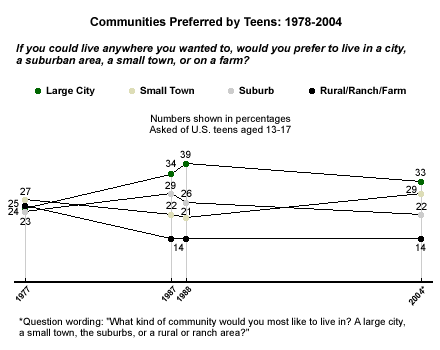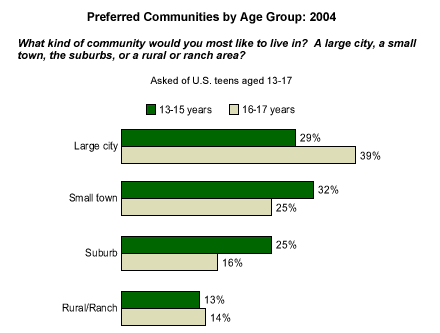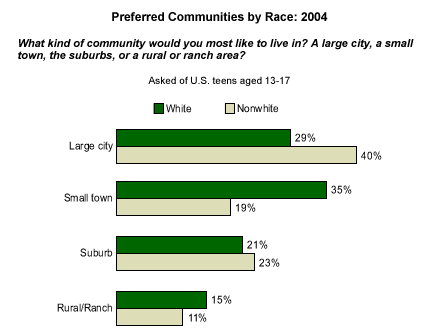When American teens are asked what type of community they'd like to live in, they're most likely to say they'd head to the bright lights of the big cities. This finding has held true since the latter 1980s, when the Gallup Youth Survey documented a shift in teens' preferences.
When Gallup first asked this question of teens in 1977, the four options offered -- big cities, suburbs, small towns, and farms -- held roughly equal appeal for teens, with roughly a quarter of the teen population saying they'd prefer to live in each. But when Gallup asked the question again 10 years later, interest in living on a farm had declined by 11 percentage points -- from 25% to 14% -- similar to the percentage of teens who would live in a rural or ranch area today. The farm's loss has been the city's gain: A third (33%) of teens in the latest Gallup Youth Survey* say they want to live in cities. Twenty-nine percent of teens prefer to live in a small town, 22% prefer the suburbs, and 14% prefer rural areas.

Older Teens Prefer the Bright Lights
Girls are slightly more attracted to large cities than boys are, 37% vs. 29%, respectively, and boys are more likely to say they prefer small towns -- 33% compared with 25% of girls. The data also suggest that rural areas have more appeal to boys (17%) than to girls (10%). Eddie, a 16-year-old who lives in a small town in western Pennsylvania, may be typical of teen boys who prefer small-town life. "It's safer with less crime -- and the people are friendlier," he says.
Younger teens (those between the ages of 13 and 15) are about equally divided in their preferences for cities (29%) and small towns (32%). Twenty-five percent would live in the suburbs, and only 13% would choose to live in a rural area. Older teens (aged 16 and 17) prefer city living (39%) to living in small towns (25%), suburbs (16%), and farms (14%).

White-Nonwhite Teen Preferences
Forty percent of nonwhite teens say they would prefer to live in a big city, compared with 29% of white teens. According to the 2000 Census, most minorities live in urban areas, therefore, it's not surprising that many prefer to continue living there. A plurality of white teens (35%) however, would prefer small-town living. Smaller proportions of both white teens and nonwhite teens would elect to live in the suburbs or rural areas.

Bottom Line
If the past is truly a prologue, these findings don't augur well for economic conditions in rural areas. This month's National Geographic cover story, "Change of Heartland," details the population downturn in rural America that began after World War II. Educational and employment opportunities expanded after the war, beginning the great migration from farm to city and suburb.
Dr. James Hoy, director of The Center for Great Plains Studies at Emporia (Kans.) State University and a student of rural America, says the problem goes even deeper than that. Responding to Gallup data that show a drop in interest in country life among teens between 1977 and 1987, he notes, "a sudden burst of popular, urban culture" during that period. "The Western movie dropped from favor. Even traditional country music made the crossover to a growing, urban culture at that time," Hoy says. "Technology and the rise of corporate farming have also worked against rural America. I remember a sign in Kansas in the 1960s that read, ‘One farmer feeds 67 people.' Today a similar sign reads, ‘One farmer feeds 200 people.' The myth of the family farm is just that -- a myth, and it's gone forever."
*The Gallup Youth Survey is conducted via an Internet methodology provided by Knowledge Networks, using an online research panel that is designed to be representative of the entire U.S. population. The current questionnaire was completed by 785 respondents, aged 13 to 17, between Jan. 22 and March 9, 2004. For results based on the total sample, one can say with 95% confidence that the maximum margin of sampling error is ±4 percentage points.